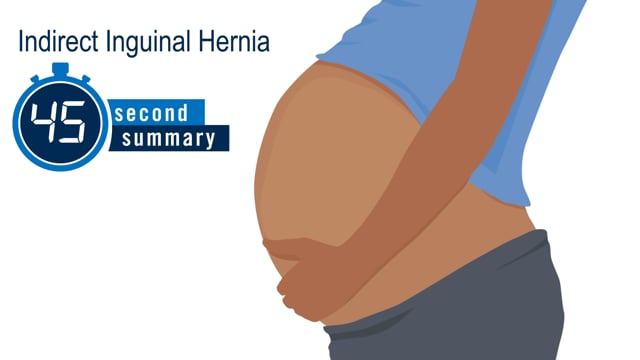Inguinal Hernias
What Are Inguinal Hernias?
An inguinal hernia happens when part of the intestines slips into the groin (where the belly meets the upper leg) instead of staying in the belly as it should.
Doctors fix inguinal (IN-gwuh-nul) hernias with surgery. This prevents the intestines from getting stuck (“incarcerated”) in the groin. Blood flow can get blocked to an incarcerated intestine, which can lead to damage. This is a medical emergency. It is best if doctors can fix hernias before they become emergencies.
Who Gets Inguinal Hernias?
People of all ages can get an inguinal hernia. In kids, they’re much more common in boys, but girls can get them too.
Children who are born early (preemies) are more likely to have an inguinal hernia.
-

45-Second Summary: Indirect Inguinal Hernia
Learn the basics in 45 seconds.
What Are the Signs & Symptoms of an Inguinal Hernia?
The main sign of an inguinal hernia is a visible bulge under the skin in the groin or scrotum. A child can have a bulge in one or both sides of the groin.
Other signs can include:
- pain, especially when bending over, straining, lifting, coughing, or crying
- pain that improves during rest
- weakness or pressure in the groin
- in boys, a swollen or enlarged scrotum
- burning or aching feeling at the bump site
The hernia can get bigger and smaller:
- It can get bigger when a child does something that creates pressure in the belly, like standing up, crying, coughing, or straining to poop.
- It can get smaller again when the child lies down and is calm.
In babies, the hernia might be visible only when the infant cries, coughs, or strains to poop. Parents also might notice that the baby is cranky and eating less than usual.
What Causes Inguinal Hernias?
There are different types of inguinal hernias. A common type in babies and young kids happens when the intestines slide into a pathway called the inguinal canal in the groin area, rather than staying in the belly.
When a baby boy develops in the womb, the testicles travel from the belly to the scrotum through the inguinal canals. These pathways should close up before birth. If one stays open, a boy’s intestines can slip into the inguinal canal and into the scrotum, forming a hernia. Girls don’t have testicles, but they do have inguinal canals, and can have inguinal hernias.
How Are Inguinal Hernias Diagnosed?
If your child has any pain or swelling in the groin or scrotum, call your doctor. The doctor will do an exam and ask about your child’s medical history.
To feel the hernia as it moves into the groin or scrotum, the doctor might have your child stand and cough. The doctor will gently try to massage the hernia back into its proper place in the belly. A hernia that can be massaged back into place is called a “reducible” hernia. But these also need surgery because they won’t stay in place.
How Are Inguinal Hernias Treated?
Inguinal hernia repair surgery is one of the most common types of surgery done on kids. Surgery is needed so that an inguinal hernia doesn’t get stuck and cause damage to the intestines.
During surgery:
- The child gets anesthesia to not feel any pain.
- The surgeon makes a small incision (cut) in the skin. In boys, they’ll move the hernia away from the spermatic cord, which carries the blood supply for the testicle and the pathway for sperm. Then, the surgeon puts the part of the intestines that are inside the hernia back where it belongs.
- The surgeon closes the opening to help prevent another hernia.
Small tape strips will cover and close the incision site. These will fall off on their own in 1–2 weeks.
What Happens After the Surgery?
Most children can go home a few hours after the surgery. Babies born early may be watched overnight after having anesthesia.
Things to know:
- Give any prescribed medicine or over-the-counter pain medicine exactly as directed.
- Your child may have some swelling and bruising near the surgery area. Boys may have swelling of the scrotum. Apply cool compresses (a freezer pack or a bag of ice wrapped in a towel) to the area to help with swelling.
- Some kids get constipated (have trouble pooping) after surgery. Offer plenty of liquids (such as water and prune, pear, and apple juice), plus high-fiber fruits and vegetables (such as pears, strawberries, and sweet potatoes). Avoid cheese, bananas, and white rice.
- Your child can eat normally and go back to usual activities as soon as he or she feels up to it, usually in a few days.
- Your child should have a sponge bath for the next day or two rather than a tub bath or shower.
- Your child should not climb, play sports, or lift objects heavier than 10 pounds (about the weight of a gallon of milk) until the surgeon says it’s OK.
- Your child should not ride a bicycle or use a riding or straddle toy until the surgeon says it’s OK.
- If the tape strips don’t fall off on their own, the doctor will take them off at your child’s follow-up visit after surgery.
When Should I Call the Doctor?
Call the surgeon if your child had surgery and:
- has a fever of 101.5°F (38.6°C) or higher
- has redness that spreads around the surgery area
- has bleeding, swelling, or drainage from the surgery area
- has severe, lasting pain at the surgery area
- is very cranky or irritable
- hasn’t peed within 8–12 hours after surgery
- is vomiting
- is not drinking or eating
